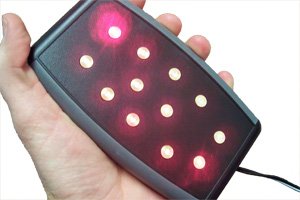Transcranial Low-Level Laser Therapy
Low-Level Laser Therapy is a unique form of laser light that reduces inflammatory mediators such as prostanglandins, decrease bleeding, and improve mitochondrial ATP production. LLLT has been shown to penetrate the skull to directly aid damaged neurological tissue.
In addition to Traumatic Brain Injuries, LLLT has also been found to help with the effects of a stroke, degenerative central nervous system disease, spinal cord injuries, peripheral nervous system degeneration, and even hair loss! It can also easily be used at home by the patient, saving them time and money, while also giving them the autonomy to help heal themselves.

Studies:
In a study by Knight et al, 2 human subjects were found to have improved cognition and sleep after a series of transcranial, red, and NIR LED treatments. There was also a decrease in post traumatic stress disorder. Both patients with TBI reported if they stopped treatment for 1-2 weeks, their cognitive problems returned. “LLLT acts by inducing a photochemical reaction in the cell, a process referred to as biostimulation or photobiomodulation. Photo-biology works on the principle that, when light hits certain molecules called chromophores, the photon energy causes electrons to be excited and jump from low-energy orbits to higher-energy orbits. In nature, this stored energy can be used by the system to perform various cellular tasks, such as photosynthesis and photomorphogenesis.” In another study using mice as subjects, researchers were able to inject bromodeoxyurdine (BrdU) roughly 21 days after treatment started with LLLT. This allowed researchers to see any proliferating cells, in other words, cell growth. They found more BrdU-positive cells after treatment, suggesting that LLLT may increase neurogenesis. This study, conducted by Borlongan, et al., provides significant improvements in a neurological standpoint. Read the study here.
References:
- Borlongan, C. V. Transcranial Low-Level Laser Therapy Improves Neurological Performance in Traumatic Brain Injury in Mice: Effect of Treatment Repetition Regimen. PLoS ONE, e53454. Retrieved May 28, 2014, from http://www.plosone.org/article/info%3Adoi%2F10.1371%2Fjournal.pone.0053454
- Hamblin, M. R. Role of Low-Level Laser Therapy in Neurorehabilitation. PM&R, S292-S305. Retrieved May 28, 2014, from http://www.ncbi.nlm.nih.gov/pmc/articles/PMC3065857/#__ffn_sectitle
- Hamblin, M. R. Transcranial low level laser (light) therapy for traumatic brain injury. Journal of Biophotonics, 827-837.
- Knight, J. A. Improved Cognitive Function After Transcranial, Light-Emitting Diode Treatments in Chronic, Traumatic Brain Injury: Two Case Reports. Photomedicine and Laser Surgery, 351-358. Retrieved May 28, 2014, from http://www.ncbi.nlm.nih.gov/pmc/articles/PMC3104287/#__abstractid1190707title
